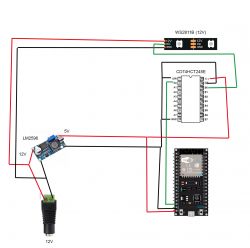Hi,
I apologise in advance for the excellent quality of the diagram.
 .
.
Namely, a seemingly simple matter like wiring up an ESP32-controlled LED strip turned out to be much more cumbersome. At this point I have burnt out 3 x ESP32 which is annoying to say the least.
I'll perhaps start at the back, as I don't quite understand why the chip burn-ups only occurred when directly plugging DATA from the GPIO into the LED strip. As far as I understand there is a microscopic current flowing through the DATA so the only risk of burning is a reverse current due to a short somewhere at LED strip level. How then to check the LED strip?
Also I wanted to ask if it is normal when checking with a multimeter on the "LED test" with the strip plugged in that:
- GND to GND, + to + -> beeping
- GND to +, + to GND -> steady beeping (short circuit)
What did I check?
- power on the belt is there
- connections are correct (checked with multimeter)
- the code is straightforward and "sometimes" worked (if the ESP32 didn't burn out...)
- GND on voltage regulator are common (checked with multimeter)
- DIR I gave to LOW and HIGH (according to the datasheet it should be HIGH, so that data is transferred from A to B)
I'm running out of ideas which way to go next; especially as the magic balloon has already flown a few times.
With the strip connected to power on the first pads (before the first diode) I have between GND - 12V DATA - 12V -> ~12V. I assume this should not be the case, but it seems to be the case on all strips (I have four). Maybe this is where to look for the cause?
The only way I have been able to pass data to the strip is directly from DATA from the ESP32 with an additional resistor (330Ohm) however this has not always worked and I have no dependencies.
Thank you in advance for your suggestions!
And I would appreciate your comments as this is my first post on this famous forum .
.
AI: Can you describe how exactly you have the ESP32, 74HCT245E level shifter, LM 2596 voltage regulator and WS2811 LED strip connected? Details of the connections may help identify the problem. .
I am posting a diagram.
AI: What are the specifications of the power supply you are using to power the LED strip and ESP32? I am referring to the voltage and current rating. .
12V 10A, while I will probably use a Korad with protection in further tests though.
I apologise in advance for the excellent quality of the diagram.
 .
.
Namely, a seemingly simple matter like wiring up an ESP32-controlled LED strip turned out to be much more cumbersome. At this point I have burnt out 3 x ESP32 which is annoying to say the least.
I'll perhaps start at the back, as I don't quite understand why the chip burn-ups only occurred when directly plugging DATA from the GPIO into the LED strip. As far as I understand there is a microscopic current flowing through the DATA so the only risk of burning is a reverse current due to a short somewhere at LED strip level. How then to check the LED strip?
Also I wanted to ask if it is normal when checking with a multimeter on the "LED test" with the strip plugged in that:
- GND to GND, + to + -> beeping
- GND to +, + to GND -> steady beeping (short circuit)
What did I check?
- power on the belt is there
- connections are correct (checked with multimeter)
- the code is straightforward and "sometimes" worked (if the ESP32 didn't burn out...)
- GND on voltage regulator are common (checked with multimeter)
- DIR I gave to LOW and HIGH (according to the datasheet it should be HIGH, so that data is transferred from A to B)
I'm running out of ideas which way to go next; especially as the magic balloon has already flown a few times.
With the strip connected to power on the first pads (before the first diode) I have between GND - 12V DATA - 12V -> ~12V. I assume this should not be the case, but it seems to be the case on all strips (I have four). Maybe this is where to look for the cause?
The only way I have been able to pass data to the strip is directly from DATA from the ESP32 with an additional resistor (330Ohm) however this has not always worked and I have no dependencies.
Thank you in advance for your suggestions!
And I would appreciate your comments as this is my first post on this famous forum
AI: Can you describe how exactly you have the ESP32, 74HCT245E level shifter, LM 2596 voltage regulator and WS2811 LED strip connected? Details of the connections may help identify the problem. .
I am posting a diagram.
AI: What are the specifications of the power supply you are using to power the LED strip and ESP32? I am referring to the voltage and current rating. .
12V 10A, while I will probably use a Korad with protection in further tests though.






